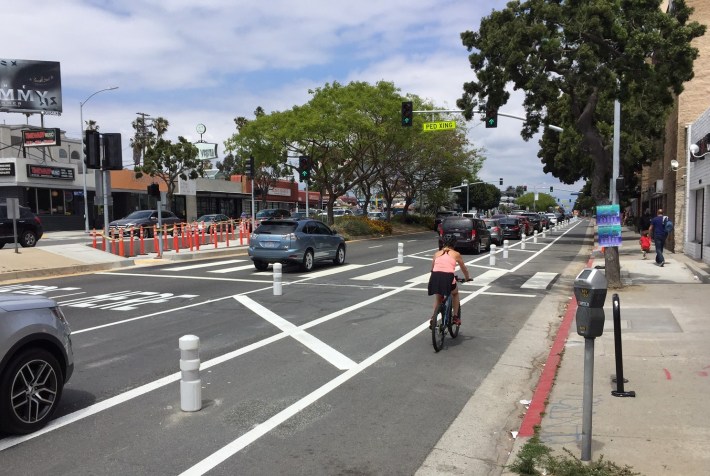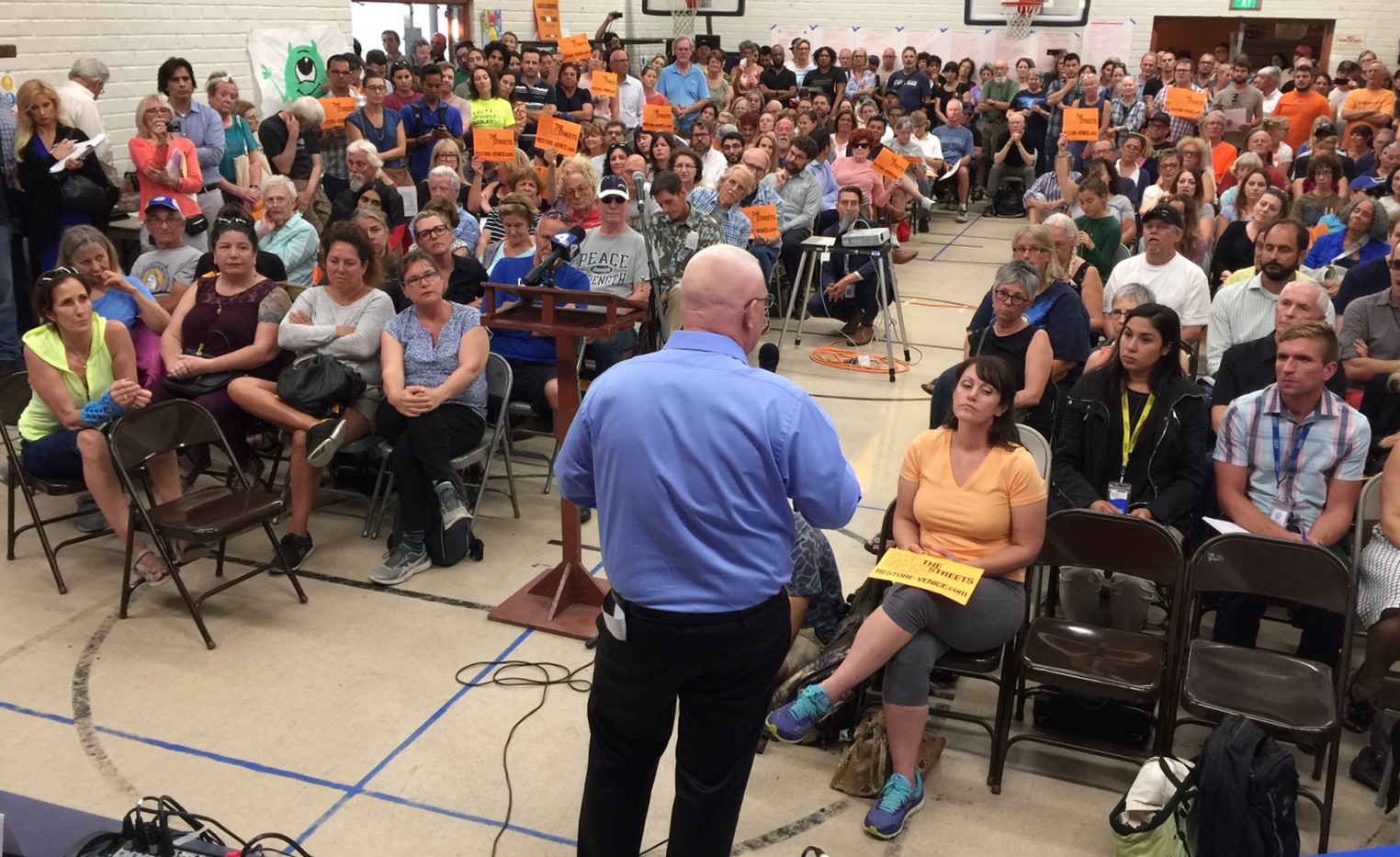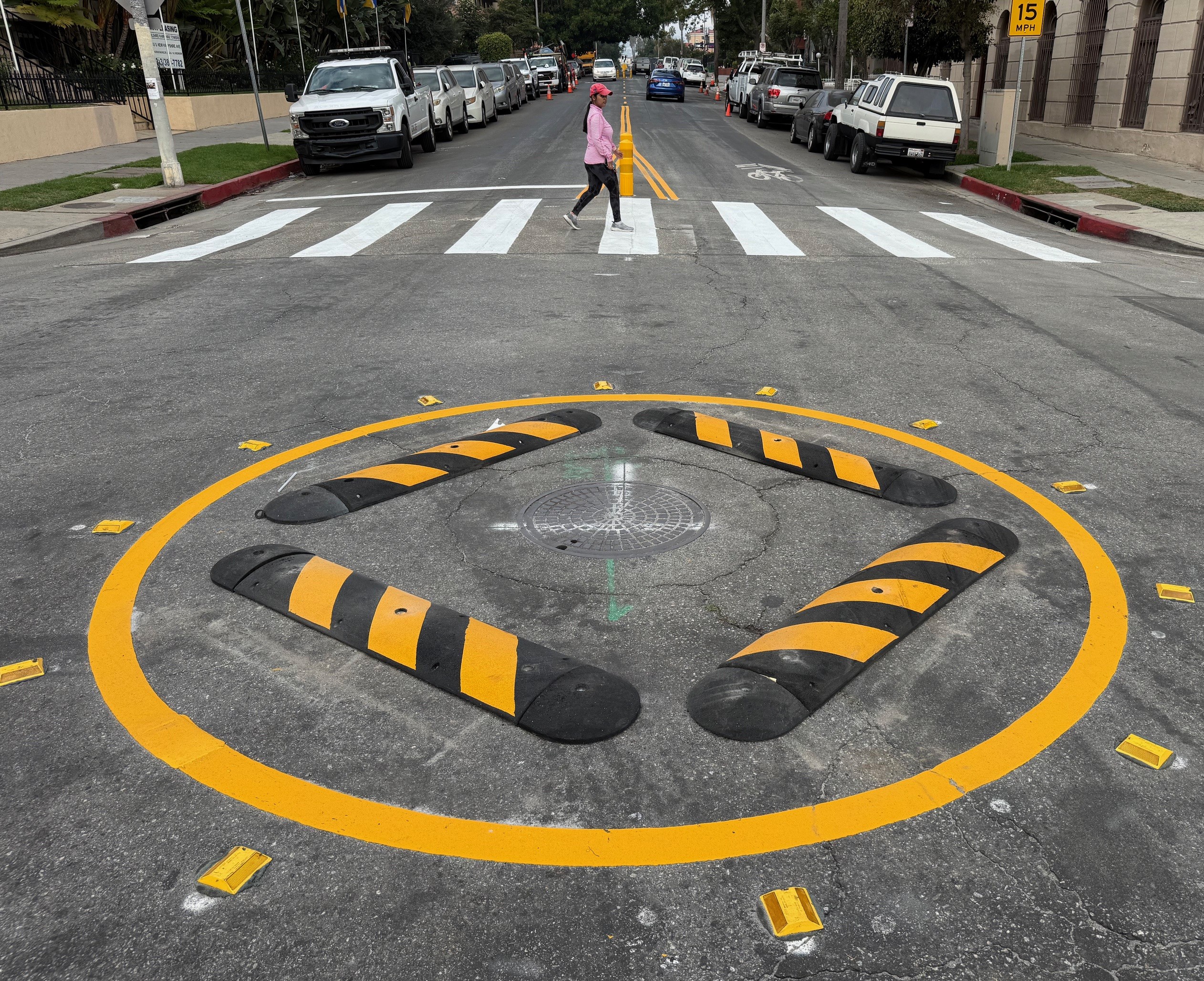Last night a crowd of about 300 people gathered at the Mar Vista Community Council's meeting where the board took action on the Venice Boulevard Great Streets project. On the council's agenda were two motions regarding Venice Blvd. The board rejected a motion calling to immediately reverse the Venice lane reduction, and approved a motion that keeps the project intact while calling for data to inform a future assessment.

The 0.8-mile Mar Vista Great Streets safety improvements are located on Venice Boulevard from Inglewood Boulevard to Beethoven Street. They opened in late May. The city added new mid-block crosswalks and protected bike lanes, while reducing car traffic from six lanes to four. The safety improvements are part of the mayor's Great Streets initiative, and respond to excessive levels of traffic deaths and serious injuries. This stretch of Venice Boulevard is identified as a priority corridor on the L.A.'s Vision Zero High Injury Network.
Both project supporters and opponents had organized to turn out their sides for extensive public comment. Project supporters applauded frequently when speakers expressed pro-livability statements. Project opponents applauded their side's statements, while also frequently shouting, booing, and hissing to interrupt project proponents. Frequent opponent outbursts included "change it back!", "restore Venice!", and "recall!".
Los Angeles City Councilmember Mike Bonin, a strong supporter of multi-modal transportation and Vision Zero, opened the meeting with a short speech. Bonin, between project opponent hisses and outbusts, reviewed the process, and intent of the project. Bonin emphasized that the project needs to make Mar Vista safe "for the next generation" and this includes slowing speeds "without causing tremendous congestion." Bonin related an anecdote that while he walked on Venice Blvd he heard from "kids cycling safely" that "this is now the safest street in Los Angeles."
Bonin acknowledged that project feedback has been mixed across numerous constituencies. He stated that he has heard from car commuters who report significant delays while others report it has not impacted them. Bonin stated that he has received positive and negative responses from businesses, cyclists, and seniors. He emphasized that he was there to listen, and that he will use feedback and data to evaluate to make changes as needed.
Bonin's remarks were followed by a presentation by L.A. City Department of Transportation (LADOT) Vision Zero lead Nat Gale. Gale emphasized the project's nearly three-year-long community outreach process, Vision Zero, and LADOT's commitment to monitor and make adjustments.
Two hours of public comment were roughly evenly divided, with nearly 60 speakers on each side.
Project proponents emphasized the need for safety in response to personal histories of collisions, injuries, and relatives' traffic deaths. Speakers also brought up climate change, noise pollution, excessive space still dedicated to cars, and improved conditions for seniors and disabled. Proponents emphasized giving the recently opened project a chance to prove itself.
Project opponents raised issues of impacted commute times, emergency response delays, tsunami evacuation routes, disabled access, scofflaw cyclists, excessive Westside development, worsened air quality, and untrustworthy city data - questioning whether the project actually makes the street safer. Ironically, supporters held up orange paper signs stating "stop the unsafe streets project." Opponent statements included "we want our lane back now," "L.A. runs on four tires and an internal combustion engine" and "this is not Amsterdam, this is Mar Vista."
The Mar Vista Community Council board initially appeared somewhat split. Some boardmembers expressed frustration with the project, especially citing business opposition and emergency responder access. Other boardmembers expressed frustration with "disgusting" project opponent behavior, especially jeers and laughter directed at Streets Are For Everyone founder Damian Kevitt who lost a leg to a hit-and-run driver.
The board voted 8-3 against a motion to "immediately reverse the lane reduction and return Venice Boulevard to the long established six lane configuration." It then voted 10-1 to approve a motion supporting Vision Zero and a six-month reassessment, while asking for various data to inform the assessment:
- LAPD and LAFD response time data
- an evaluation be done by an ADA consultant
- a safety evaluation by established bicycle safety advocacy groups
- city surveys, petitions, traffic studies, and community impact reports
- data on cut-through traffic on neighborhood streets
- LADOT data from other city streets with the same configuration
MVCC's vote echoes a similar approval by a Venice Neighborhood Council committee last week.
Overall, the council's affirmation of the project, the large mobilization of livability advocates, LADOT's implementation of key facilities to advance Vision Zero, and the continuing leadership of Councilmember Bonin, all point to last night's vote as an important victory. The city can implement excellent courageous projects that prioritize safety while balancing the needs of all road users. These projects can save lives.
Bonin and LADOT will be hosting an upcoming open house to share data and gather further input on the Venice Blvd Great Streets project. The next open house will take place on Saturday July 22 from 1 to 3 p.m. at the Windward School gym at 11350 Palms Boulevard in Mar Vista.






